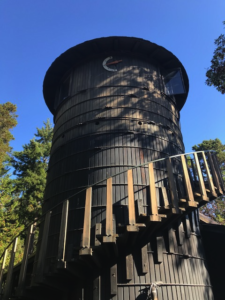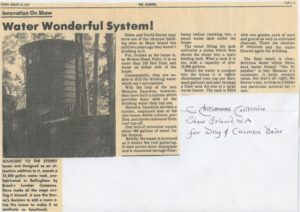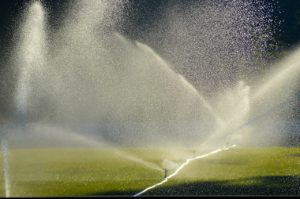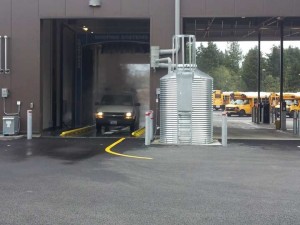 RainBank Rainwater Systems thanks all those who have served our nation.
RainBank Rainwater Systems thanks all those who have served our nation.
We are grateful for your service.
 RainBank Rainwater Systems thanks all those who have served our nation.
RainBank Rainwater Systems thanks all those who have served our nation.
We are grateful for your service.
 A designed rainwater collection system for the ages, Storey’s water tower was designed and built as a sole source rainwater collection system for a household in the San Juan Islands of Washington State. The Storeys constructed a home on an isthmus with panoramic water views facing either side of the house. While spectacular, there was little chance of drilling a potable well, since water was only 150 feet from either side of the house. The total square foot of the house and shop would yield approximately 900 gallons per inch of rainfall.
A designed rainwater collection system for the ages, Storey’s water tower was designed and built as a sole source rainwater collection system for a household in the San Juan Islands of Washington State. The Storeys constructed a home on an isthmus with panoramic water views facing either side of the house. While spectacular, there was little chance of drilling a potable well, since water was only 150 feet from either side of the house. The total square foot of the house and shop would yield approximately 900 gallons per inch of rainfall.
The water is screened as it enters the roof gutter system, then finer screening and sedimentation occurs before gravity feeding into the sump tank. A float switch will activate a sump pump to convey water to this magnificent water tower, with a office space on top, to enjoy those views.
The system is pressurized with a with a centrifugal pump and pressure tank which feeds a 5-micron sediment filter followed by carbon filtration. The Story’s were pleased with their new system even though “It lacks mineral value, but that’s alright, as long as it keeps one mineral out – salt water.”, said Mrs. Storey. That was 1977!
 Coincidentally, I visited this house in the mid-eighties, before I had knowledge of rainwater collection. I was fascinated with the concept and impressed with the design and craftsmanship. The thought of a self-sustaining water system, when no other source was available, made perfect sense. The simple mechanics of prescreening, pre-filtering, and pressurized conveyance is the basis of best practices still used today.
Coincidentally, I visited this house in the mid-eighties, before I had knowledge of rainwater collection. I was fascinated with the concept and impressed with the design and craftsmanship. The thought of a self-sustaining water system, when no other source was available, made perfect sense. The simple mechanics of prescreening, pre-filtering, and pressurized conveyance is the basis of best practices still used today.
I had an opportunity last month to conduct an inspection of this system for the new owners and was thrilled to see. with a few improvements and UV sterilization, this system is still producing a sustainable source of potable water, and can be expected to continue for another forty years.
 Do you know that the most common use of collected rainwater is not for drinking? Here’s a prior post, which helps answer this question – and explains why non-potable use of rainwater is so popular – and sustainable.
Do you know that the most common use of collected rainwater is not for drinking? Here’s a prior post, which helps answer this question – and explains why non-potable use of rainwater is so popular – and sustainable.
The most common use of rainwater collection is for non-potable use. Irrigation, water features, wash down, toilet, and laundry are all non-potable uses that can have a positive effect on water conservation. A properly designed and installed rainwater collection system will provide enough water to support these desired uses with less impact on our water supply.
Rainwater is essentially free of pollution, so it can be stored without much more than screening. Storage can be underground, above ground, metal, plastic, or fiberglass. If irrigation is the desired use, keep in mind that approximately .623 gallons per sq ft of planting, per week is required for the healthy growth of plants, therefore storage volumes can be a concern in design due to space and costs. Conveyance can be gravity if there is enough head. Head is .4 lbs per foot of elevation. A pressure pump might be necessary to achieve the desired pressure needed. Sediment filtration for a simple irrigation system should be all that is needed to ensure emitters and soaker hoses perform as expected.
Water features such as fountains can recirculate the water being used, so very little storage would be required. Sediment and carbon filtration would be needed to keep pumps and nozzles working properly. A carbon filter would be helpful to keep odor to a minimum.
 Wash down facilities can use rainwater collection and save money on their water bills by using rainwater collection as the rinse water. With enough storage, a large fleet can be washed with recycled wash water and rinsed with collected rainwater. Again, sediment and carbon filtration would be the only filtration needed. Wash down of equipment, whether construction or farming, can benefit from rainwater collection.
Wash down facilities can use rainwater collection and save money on their water bills by using rainwater collection as the rinse water. With enough storage, a large fleet can be washed with recycled wash water and rinsed with collected rainwater. Again, sediment and carbon filtration would be the only filtration needed. Wash down of equipment, whether construction or farming, can benefit from rainwater collection.
Toilet and laundry facilities for residential and commercial applications are becoming more popular with new construction. Rather than infiltration, which is mandated, why not use that water. Simple pumping and filtration of stored water is all the treatment needed. A return on investment can be achieved within a few years.
There are a wide range of uses for rainwater collection. With a little bit of imagination, you might come up with a use for rainwater collection that could save you money.
So, the next time you think collecting rainwater for drinking purposes is most common, think again – there are many more uses that are beneficial and sustainable.